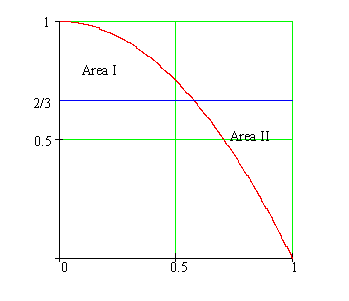
Resources
Math 3 Course Home Page
Math 3 Course Syllabus
Practice Exams
Textbook Home Page
Post a Comment
Contents
In this lecture we study something called the "Mean Value Theorem." This theorem allows us to take an "at-a-point" concept like the derivative and use it to study the global behavior of a function. We will also learn how to differentiate a function for which we do not have an explicit formula.
Quick Question
Suppose Area I (above the blue line and below the parabola) equals Area II (above the parabola and below the blue line). What is the total area enclosed by the parabola?
Outline
Outlines forThe Mean Value Theorem
Implicit Differentiation
Textbook
The Mean Value TheoremImplicit Differentiation
Today's Homework
Log into WebWorKQuiz
The Mean Value Theorem QuizImplicit Differentiation Quiz
Examples
-
 At 7 p.m., a car is traveling at 50 miles per hour. Ten minutes later, the car has slowed to 30 miles per hour. Show that at some time between 7 and 7:10 the car's acceleration is exactly 120, in units of miles per hours squared.
At 7 p.m., a car is traveling at 50 miles per hour. Ten minutes later, the car has slowed to 30 miles per hour. Show that at some time between 7 and 7:10 the car's acceleration is exactly 120, in units of miles per hours squared.
-
 At a particular horse race, two horses start at the same time, and finish in a tie. Show that at some time during the race, the horses were running at the same speed.
At a particular horse race, two horses start at the same time, and finish in a tie. Show that at some time during the race, the horses were running at the same speed.
-
 Suppose f is a differentiable function such that f(1) = 20, f'(x) ≥ 3, 1 ≥ x ≥ 6. What is the smallest possible value for f(6)?
Suppose f is a differentiable function such that f(1) = 20, f'(x) ≥ 3, 1 ≥ x ≥ 6. What is the smallest possible value for f(6)?
-
 Find y' by implicit differentiation, where xy = cot(xy).
Find y' by implicit differentiation, where xy = cot(xy).
-
 Find the tangent line to an ellipse at a given point.
Find the tangent line to an ellipse at a given point.
-
 An interesting curve first studied by Nicomedes around 200 B.C. is the conchoid, which has the equation x2y2 = (x + 1)2 (4 – x2). Use implicit differentiation to find a tangent line to this curve at the point (–1, 0).
An interesting curve first studied by Nicomedes around 200 B.C. is the conchoid, which has the equation x2y2 = (x + 1)2 (4 – x2). Use implicit differentiation to find a tangent line to this curve at the point (–1, 0).


